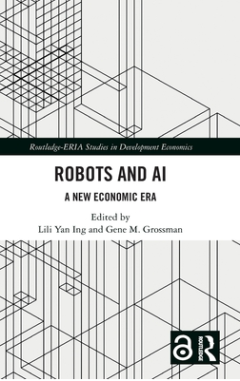Ditapis dengan
E-book Chamber of Shipping : Monaco
The shipping sector supports and enables more than 90 % of the world’s international trade. This complex and dynamic industry underpins passengers' transportation on ferries and cruise ships as well as moving all kinds of cargo on container, bulk and tanker vessels. In the Principality of Monaco, the shipping industry represents in excess of 4% of the country‘s GDP and employs more than 1.0…
- Edisi
- -
- ISBN/ISSN
- -
- Deskripsi Fisik
- 52 hlm
- Judul Seri
- -
- No. Panggil
- 382.449 LEF c
E-book Regions in International Trade
Export activity has been traditionally analysed for countries. Its regional dimension was somewhat neglected or not noticed. The main premise of our research is that exports are strongly diversified regionally. The imperative to conduct such research stems from constatation that exports do not come from an undefined space, from a country treated as a s…
- Edisi
- -
- ISBN/ISSN
- 9788395815041
- Deskripsi Fisik
- 266 hlm
- Judul Seri
- -
- No. Panggil
- 382 UMI r
E-book World Trade Statistical Review 2023
The World Trade Statistical Review 2023 presents recent trends in international trade at a time of geopolitical and macroeconomic strains and technological challenges affecting the global economy and supply chains. The data cover merchandise and services trade broken down by geographical origin, main product groups and sectors, along with related data on key economic developments such as GDP gr…
- Edisi
- -
- ISBN/ISSN
- -
- Deskripsi Fisik
- 138 halaman, ilus.
- Judul Seri
- -
- No. Panggil
- 382 WTO w
E-book Trade Map User Guide : Trade Statistics for International Business De…
Beyond the six-digit level, the classification becomes national and countries are free to introduce national distinctions by adding more digits to make the HS classification of products even more specific. This greater level of specificity is referred to as the National Tariff Line (NTL) level and is used by countries to identify specific products to which a tariff is attributed. For example, C…
- Edisi
- -
- ISBN/ISSN
- -
- Deskripsi Fisik
- 126 hlm
- Judul Seri
- -
- No. Panggil
- 381 MAR t
E-book The Silk Roads : An ICOMOS Thematic Study
From as early as 2003 consideration was being given to the development of a transboundary nomination for the Silk Roads (Jing & van Oers 2004). A series of sub-regional workshops were then developed, in Almaty in November 2005, Turfan in August 2006, Samarkand in October 2006 (UNESCO 2006), Dushanbe in April 2007, Xi’an in June 2008, and Almaty in May 2009 (UNESCO 2009a), all of which culmina…
- Edisi
- -
- ISBN/ISSN
- 9782918086123
- Deskripsi Fisik
- 164 hlm
- Judul Seri
- -
- No. Panggil
- 382 WIL t

E-book Robots and AI
Robots and artificial intelligence (AI) are powerful forces that will likely have large impacts on the size, direction, and composition of international trade flows. This book discusses how industrial robots, automation, and AI affect international growth, trade, productivity, employment, wages, and welfare. The book explains new approaches on how robots and artificial intelligence affect the w…
- Edisi
- -
- ISBN/ISSN
- 9781003275534
- Deskripsi Fisik
- -
- Judul Seri
- -
- No. Panggil
- 629 ING r
E-book Trade and Employment : From Myths to Facts
Those numbers, however, do not indicate that interviewees have an entirely negative perception of globalization. Indeed, evidence based on surveys that make a distinction between growth and employment impacts of globalization reveals that a majority of respondents in industrialized countries believes in the positive growth effects of globalization that are so often emphasized in the public deba…
- Edisi
- -
- ISBN/ISSN
- 9789221253211
- Deskripsi Fisik
- 318 hlm
- Judul Seri
- -
- No. Panggil
- 381 JAN t
 Karya Umum
Karya Umum  Filsafat
Filsafat  Agama
Agama  Ilmu-ilmu Sosial
Ilmu-ilmu Sosial  Bahasa
Bahasa  Ilmu-ilmu Murni
Ilmu-ilmu Murni  Ilmu-ilmu Terapan
Ilmu-ilmu Terapan  Kesenian, Hiburan, dan Olahraga
Kesenian, Hiburan, dan Olahraga  Kesusastraan
Kesusastraan  Geografi dan Sejarah
Geografi dan Sejarah